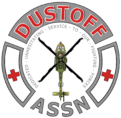Reprint from Jordan Times Thursday, July 17, 2003
BAGHDAD (AFP) — The largest ongoing US medevac operation since the Vietnam war is in full swing in Iraq as a company of Blackhawk helicopter pilots, crew chiefs and medics race across Iraqi skies — and against time — to bring aid to friend and foe. Fighting wind-whipped perma-dust, rising attacks on US forces and exhaustion, the 159th Air Ambulance company struggles to transport the growing number of wounded on both sides of a simmering conflict three months after a lightning US-led invasion ousted dictator Saddam Hussein.
The need for the emergency medical evacuation (medevac) services shows no sign of let-up as US forces come under mounting attacks by suspected Saddam loyalists — many of whom are flown to US field hospitals after sustaining injuries in gunbattles with US troops.
“We’re by far the busiest I’ve ever experienced,” says Captain James Hannam, the exhausted 30-year-old operations officer who runs the 159th, which averages more than 13 missions per day and has logged 2,200 flight hours in four months. On July 4, US Independence Day, the team flew a record 19 missions.
“Some days we barely make it. This is the busiest US medevac since Vietnam.” And perhaps the most dangerous. While the olive drab UH-60-Alpha Blackhawks are clearly marked with the red cross believed to be universally recognized, the pilots say many Iraqis appear unfamiliar with the markings.
At night the tracers float up, sometimes uncomfortably close to the Blackhawks, says crew chief Specialist Jeffrey Willis, 31.
In compliance with the Geneva Convention, the air ships can not be armed; only the personal firearms of crew members are allowed. None of the 14 medevac Blackhawks stationed at Baghdad international airport southwest of the city has been hit by ground fire since the war, Willis points out, but the discomfort he shares with his flight unit is growing, along with the number of missions they are flying.
“It’s getting worse and worse,” says Willis.
Not only the helicopter teams are at risk. A US army medic was killed last month when assailants fired a rocket-propelled grenade (RPG) on a military ambulance near Baghdad. One of the company’s 17 pilots, Warrant Officer William O’Donnell, cites increased RPG attacks and other ambushes on occupying ground forces struggling to keep the peace in Iraq.
“We’ve been busier this past month than before,” O’Donnell says.
When an urgent call comes in, a medevac team is seen scrambling out of their cramped office and running through the “Nine Line,” the medevac checklist standard to all US military units. In the most urgent situations they can be “wheels up” in five minutes, O’Donnell says. “Sometimes we go for a 15-minute job and end up staying out 10 hours, answering calls on the fly,” says Willis. A recent flight to transfer injured soldiers to a high-tech field hospital in the desert 25 kilometers southwest of the airport highlighted the precarious nature of the work. Touching down at the 28th Combat Support Hospital in the desert, Willis is given another mission: Transport four treated Iraqi enemy prisoners of war (EPWs) back to Camp Cropper prison at the airport. “We get EPWs on here all the time and we never know how they’ll react when they’re aboard,” Willis says as he orders a reporter and photographer off the chopper to make room for the handcuffed prisoners.
About 50 per cent of those medevacked are Iraqi prisoners or civilians. The flights often turn into humanitarian efforts, with teams flying injured or sick Iraqi children to US hospitals for medical care. The 159th boasts a 99 per cent survival rate — just four of their 2,200 patients have died after transfer to hospital. But the weight of the work bears down on them daily, with calls from US units under fire.
A somber-looking Chief Warrant Officer Jorge Correa stepped out of his Blackhawk early Tuesday to speak of his latest mission to evacuate a US Marine who lost half his foot to a mine south of Baghdad. Still, the crews say their chaotic stint in Baghdad has been the highlight of their careers.
“It’s everyone’s dream, to do such a job so soon out of flight school,” said pilot Chief Warrant Officer Travis Workman, who has already logged 260 flight hours in four months in Iraq. “I love this job.”
